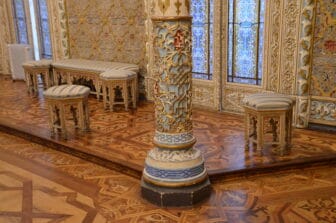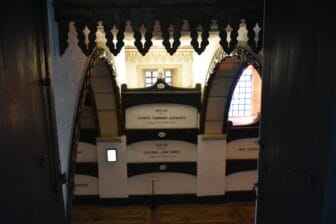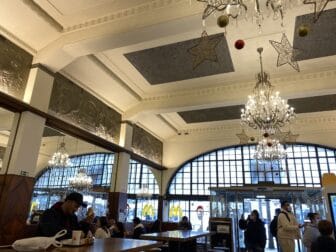
[Dec. 2021] The second half of the tuk-tuk tour in Oporto, a town in northern Portugal.
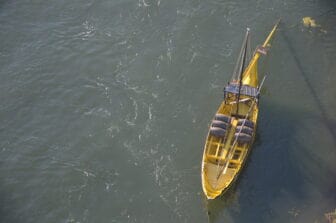
We had a commemorative photo taken on a hill along the Douro River.
As I learned at that time, the old wooden boats lined up in the river were rabelo boats that used to carry people and goods, and now they are exclusively decorations for tourists.
But once a year, they have a boat race using these rabelo boats.
In the olden days, it was this rabelo boats that brought port wine from the Douro Valley to the town of Porto.
By the way, on this hill, there was a shabby house and according to our guide, Leandro, a contractor has applied for renovation to make it a hotel in 2017, but the permission has not been granted, yet.
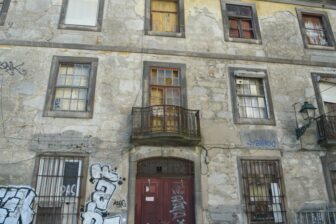
This time Oporto was bright, lively and full of vitality, but when we first visited this town 12 years ago, there were many such shabby houses like this one and it looked like a twilight town.
I remember that one street was lined with old tiled houses, and I was impressed by the fact that there was laundry in the decaying house, but where was that street?
After leaving this hill, the tuk-tuk went down the river to a residential area and parked.
What Leandro wanted to show us was a brand new escalator down the alley.
It was just made last year.
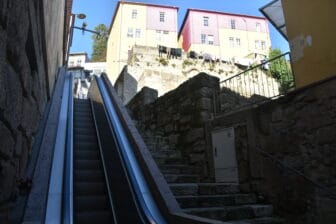
In this a quiet area, the escalator was running all the time, even though no one was using it while we were there.
Looking up from here, I saw a woman drying the laundry.
During this tour, I saw many clothes drying scenes.
Portuguese are enthusiastic about washing, or rather, enthusiastic about hanging laundry outdoors.
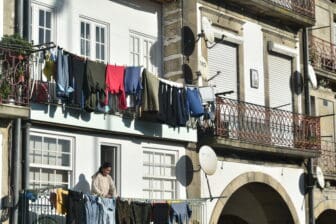
I imagine that in Portugal there are no apartments where they do not allow you to dry their laundry on the balconies, which often happens in other countries.
From there, we took a photo at the bottom of the Dom Luis I Bridge, which was under renovation work, and then crossed the Infante Bridge a little upstream, and headed to the Gaia side.
The tour ended on a hill overlooking the Dom Luiz I Bridge.
On this hill is the site of a 17th-century monastery called Mosteiro da Serra do Pilar, but the hill seems to be known as a vantage point for the view and was full of tourists.

From here, you can see not only the old town of Porto on the opposite bank and the Dom Luis I Bridge, but also the port wine warehouse district of Gaia.
Here, Leandro served a glass of port wine to us.
According to him, there are more than 80 port wine companies.
The percentage of alcohol of port wine is 19 to 22%, and white is usually taken before meals and red is taken after meals.
Some white wines can be drunk while eating like ordinary wine.
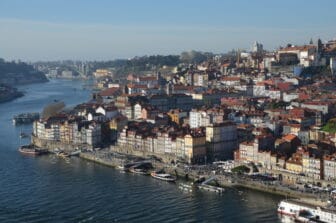
What we drank here was Calem’s red port wine.
Leandro’s favourite is a manufacturer called Vasques de Carvalho, and he pointed to the location of its warehouse from the hill.
It was a little too far away to see which one, though.
I think each person from Oporto has one’s own opinion about port wine.
And that reminded me of meeting a young waitress in Sakata City, Yamagata Prefecture, who had knowledge of sake and had a clear idea about the taste.
By the way, this Leandro is from Oporto, but his mother is from Rio de Janeiro, Brazil.
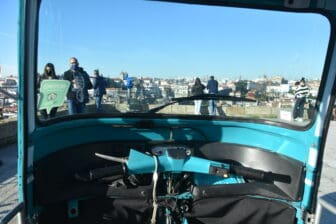
But he said he had never been to Brazil.
When asked about the relationship between Portuguese and Brazilians, he said, “Some genuine Portuguese look down on Brazilians, but in general they have a good feeling for Brazilians.”
My husband loves the young men who are working hard, so we gave him a good tip and parted.

